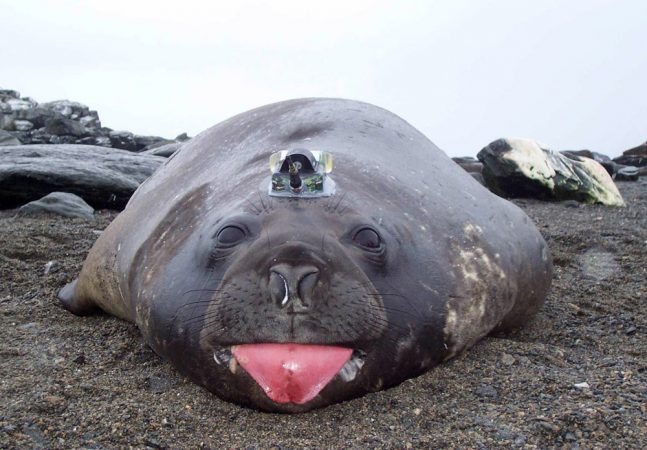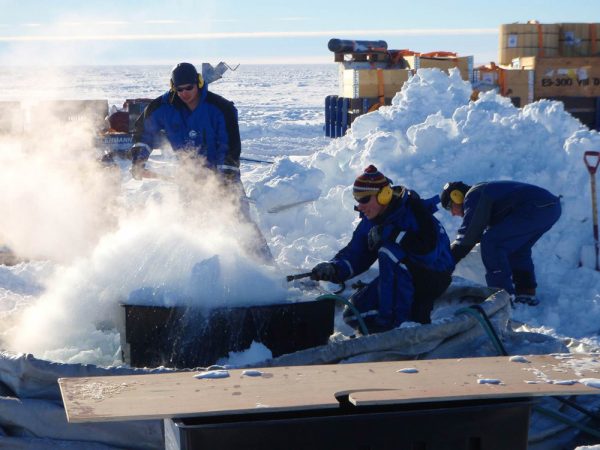Seal scientists
Elephant seals help climate scientists understand deepwater heating around Antarctica

Climate scientists concerned about global warming keep a close eye on Antarctica. There, some of the ice shelves that extend from the continent into the ocean are melting, adding freshwater that boosts sea level. Like other scientists, Tore Hattermann of the Norwegian Polar Institute wants to understand how that watery environment is changing.
But unlike other scientists, Hattermann is recruiting assistance from blubbery, nonhuman helpers.
In a recent study, elephant seals helped the researcher learn about water temperature and currents around Antarctica’s large Fimbul Ice Shelf. This monster-sized floating platform is about twice the area of New Jersey. By combining information collected by the seals with other data, Hattermann and his colleagues have found that the shelf isn’t melting as fast as earlier ocean studies had suggested. They published their new findings in June in the journal Geophysical Research Letters.
The team’s giant animal helpers — which may grow as heavy as five cows — wore sensors on their heads. These measured the water’s temperature and saltiness. Hattermann never met the seals himself. Other scientists at the institute working on a different project had already stuck sensors onto the seals’ heads. When Hattermann heard about that project, he quickly realized the seals’ data could also benefit his study.
“We were lucky that these seals were diving in exactly the same place where we were doing research,” he says.
The seals couldn’t provide all of the data that he needed. Hattermann’s team traveled to Antarctica and drilled holes all the way through the shelf. These holes gave them access to the water below (which was useful, as none of the scientists volunteered to dive that deep in the freezing water.)

Punching holes in an ice shelf is no easy task. The deepest part of the shelf where Hattermann and his crew drilled was about a half-mile, or 800 meters, thick. To lower instruments down into the water, Tore and his team needed holes about the same diameter as a Frisbee. Holes that large and deep meant a lot of drilling, and the equipment weighed about as much as six cars.
“We had to run the drill up and down a few times,” he says. From start to finish, “it took about 40 hours for the deepest holes.”
But in the end, it was worth the effort. The deep holes gave Hattermann and his coworkers a way to measure the temperature and currents of the water moving beneath the shelf. And data collected by the seals provided information on the water nearby. The animals’ contribution was useful, Hattermann explains, since much of this water will eventually move under the shelf.
Snow that falls on Antarctica stays put and will turn into ice. Gravity pulls that ice downhill, toward the ocean. This adds mass, or bulk, to the surface of a shelf. At the same time, the shelf loses some of its mass through melting, which may happen at the bottom. Scientists like Hattermann want to know if Antarctica’s ice shelves are growing or shrinking, overall. And that means studying the boundary where the ice meets the ocean.
“We are concerned about Antarctica losing mass and causing the oceans to rise,” says Hattermann. “This particular ice shelf is not as bad as ocean models were suggesting — but there are other places where it’s really burning.” In other words, he explains: “We found good news in an overall bad news situation.”
Power Words
climate change Long-term, significant change in the climate of Earth. This involves temperature, precipitation trends and even wind patterns. These changes can occur naturally or in response to human activities, including the burning of fossil fuels and cutting down forests.
global warming The gradual increase in the overall temperature of Earth’s atmosphere due to the greenhouse effect caused by a buildup in the atmosphere of carbon dioxide, methane and other pollutants.
elephant seal A large seal. The male is much larger than the female and has a very thick neck and an inflatable snout.
ice shelf A floating sheet of ice permanently attached to a land mass.
mass The quantity of matter that something contains.







